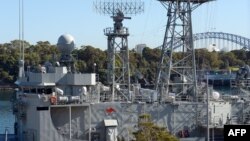The rise of India and continued tensions between the United States and China have dominated a review of Australia’s defense capabilities. The first government white paper on defense since 2009 acknowledges China's rise as a global power, but also states that the Indian Ocean is becoming strategically important.
Australia’s defense blueprint emphasizes the importance of close military ties with the United States, but also welcomes the rise of China. The white paper published Friday said the Chinese militarization is a "natural and legitimate outcome of its economic growth."
It also notes the emergence of India, which Canberra says is becoming increasingly significant both economically and diplomatically.
Australian Prime Minister Julia Gillard said the policy document reflects changing regional realities.
“The white paper underlines the enormous stake Australia has in managing strategic change in the Indo-Pacific region and managing it peacefully. In particular, in a U.S.-China relationship in which competition is minimized and cooperation maximized,” she stated.
Analysts stress that fostering closer economic ties with China and pursuing its alliance with Washington will continue to be Canberra’s biggest challenge.
The last Australian defense white paper was released in 2009. Its contents upset China, particularly when Canberra questioned the "pace, scope and structure" of Beijing's military expansion. The latest defense review is notably softer and appears to presume that China’s rising military capabilities will be peaceful.
Paul Dibb, an emeritus professor of strategic studies at the Australian National University, said this white paper rightly believes that China does not pose an immediate military threat.
“This one says very plainly that China is not seen by Australia as an adversary, and I think that is an important affirmation that yeah, we are all concerned about the rise of China, its economic power, its developing but still not comparable with American military power but anybody who really is trying to drum up as an imminent Chinese military threat, really has got rocks in their head,” said Dibb.
Australia’s defense roadmap also includes a commitment of $1.53 billion to buy 12 specialized Super Hornets fighter jets and outlines plans for 12 submarines.
The release of the white paper comes a day after Indonesian president Susilo Bambang Yudhoyono told his generals that the military should be larger than regional powers, including Australia, Malaysia and Singapore.
Australia’s defense blueprint emphasizes the importance of close military ties with the United States, but also welcomes the rise of China. The white paper published Friday said the Chinese militarization is a "natural and legitimate outcome of its economic growth."
It also notes the emergence of India, which Canberra says is becoming increasingly significant both economically and diplomatically.
Australian Prime Minister Julia Gillard said the policy document reflects changing regional realities.
“The white paper underlines the enormous stake Australia has in managing strategic change in the Indo-Pacific region and managing it peacefully. In particular, in a U.S.-China relationship in which competition is minimized and cooperation maximized,” she stated.
Analysts stress that fostering closer economic ties with China and pursuing its alliance with Washington will continue to be Canberra’s biggest challenge.
The last Australian defense white paper was released in 2009. Its contents upset China, particularly when Canberra questioned the "pace, scope and structure" of Beijing's military expansion. The latest defense review is notably softer and appears to presume that China’s rising military capabilities will be peaceful.
Paul Dibb, an emeritus professor of strategic studies at the Australian National University, said this white paper rightly believes that China does not pose an immediate military threat.
“This one says very plainly that China is not seen by Australia as an adversary, and I think that is an important affirmation that yeah, we are all concerned about the rise of China, its economic power, its developing but still not comparable with American military power but anybody who really is trying to drum up as an imminent Chinese military threat, really has got rocks in their head,” said Dibb.
Australia’s defense roadmap also includes a commitment of $1.53 billion to buy 12 specialized Super Hornets fighter jets and outlines plans for 12 submarines.
The release of the white paper comes a day after Indonesian president Susilo Bambang Yudhoyono told his generals that the military should be larger than regional powers, including Australia, Malaysia and Singapore.








